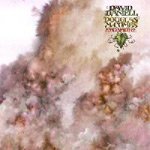Thanks in large part to tireless proselytizing by aficionados and a timely reissue campaign by Columbia, Miles Davis’ pre-retirement electric period, a stretch roughly dated as between the tentative guitar explorations of 1968’s Miles in the Sky and the release of Davis’ final 70s studio album, Get Up With It, has finally exerted its rightful, massive influence. Strains of Davis’ DNA have been mutating underground for decades, and the evidence is everywhere. The brittle, harsh repetition of On the Corner predates London’s somber pirate-broadcasted dubstep by some 30 years. And as the Holy Grail reissues of the “Pete Cosey band” prove, psych in the proper hands can turn into dark theater and transcendence all at once.
Arguably Davis’ last conventionally "beautiful" album, In a Silent Way, released in 1969, anticipated ambient by nearly 10 years. Davis’ one-off masterpiece was memorable for his instinctual ability to distill the most essential aspect of a piece of music into a moment, executed in this instance by removing the accompaniment from Joe Zawinul’s score and leaving future master John McLaughlin vulnerable and searching for answers. That moment, a clear melody tentatively picked out over a quickly building background shimmer, perfectly captured the essence of Davis: structural simplicity as window to emotional complexity.
Davis knew that jazz players look to both the underlying musical structure and other players to anchor their solos. Even free-jazz players take cues from their partners to determine velocity, density, and volume. Davis knew nothing was more terrifying for a jazz musician than an empty backdrop. By giving McLaughlin a composed piece, he left only interpretation to the guitarist, not invention. In doing so, McLaughlin could be anticipated by his partners in the studio, which allowed both the ambient build to complement the melody and a foundation for McLaughlin to develop his emotions.
Which finally brings us to David Daniell & Douglas McCombs' Sycamore, an album that combines clean guitar over glistening ambient flutters that occasionally spins off in unexpected directions. The results beg comparisons to In a Silent Way. Not only do the albums share a simple, intrinsic beauty, but just as Davis used his free reign in the studio to get a feel for the sonic dynamics that electronics brought to his music, the source material for Sycamore is also the result of extended jam sessions. And just as Teo Macero and Davis took bits and pieces to construct a cohesive album -- a method used to great effect on subsequent release Bitches Brew -- so too did Daniell and McCombs gather the resultant material and begin to mold it into compositions proper.
Yet it is precisely this necessary comparison that hampers the reception of Sycamore, because, although all the sonic elements of In a Silent Way are present, there is a palpable dearth of conceptual foresight. This type of record needs either a compelling preconceived structure or a master improviser, otherwise it will drift and lose context. But this is precisely what happens.
The primary difference with Sycamore, and perhaps the source of some of its flaws, is that the jams were not test runs, but an actual creation of source material. Judging from the meandering guitar phrases, the lack of continuity in the playing, and the uninspired interplay between foreground and background, the jamming between Daniell and McCombs seems to have been fertile in achieving an aesthetic, but inconclusive in determining a motive. Unlike Davis, Daniell and McCombs’ jamming fails to locate a unique melodic or conceptual core from which to build. As a result, there is nothing to ground the guitar phrasing, nothing to demarcate progress, nothing to tether the lightness to Earth.
This is not to say the duo is incapable of striking on exciting themes. When the pair diverts their sound from atmospherics into a faux post-rock burst towards the end of "Bursera," the satisfying climax both exhilarates viscerally and satisfies intellectually. Daniell and McCombs extend, warp, and perfectly locate this frenetic moment of inspiration to infuse the entire track with its energy and form. But such a sense of development is rare. More characteristic of the album is the frustrating stasis heard on "F# Song." Each moment begs for a concise summation of the various phrasing and would benefit greatly from the enthusiasm of "Bursera."
Unfortunately, minor aesthetics adjustments -- a distortion here and an increase in intensity in the background tones -- are only minor developments. Until Daniell and McCombs refine their aesthetic with interesting structures, the pair’s sound will remain beautiful, but frustrating.
1. F# Song
2. Bursera
3. The Deshabille
4. Vejer de la Frontera
More about: David Daniell & Douglas McCombs


